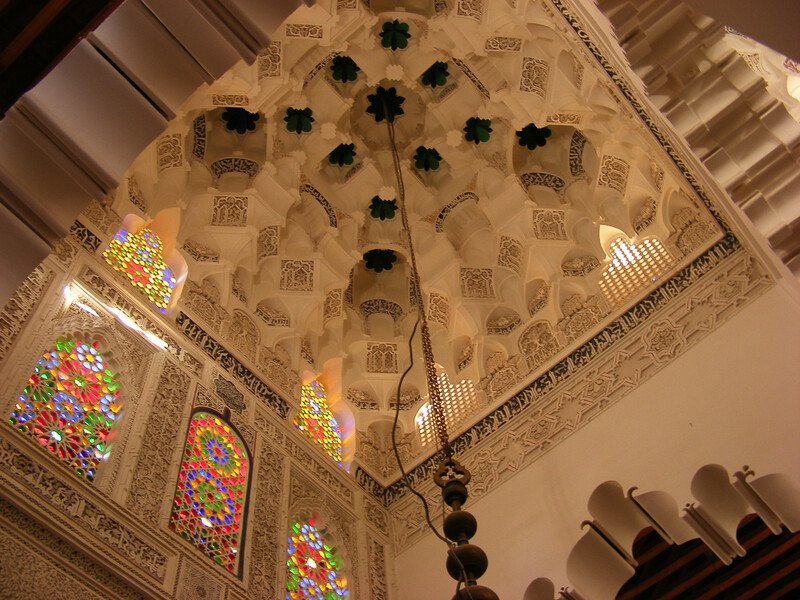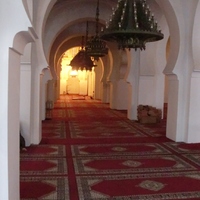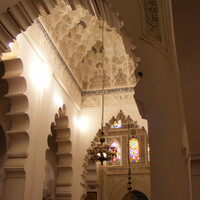Qarawiyyin Mosque-University
Date:
Mid-ninth to fifteenth century,
muqarnas vaults 1132–43
Location or Findspot (Modern-Day Country):
Morocco
Description:
Fez's al-Qarawiyyin Mosque was built or rebuilt in the mid-ninth century, allegedly by a learned woman named Fatima, daughter of a wealthy merchant who had migrated from Kairouan in Tunisia (hence the similar name of the mosque in Fez, sometimes spelled as Kairouine). It had a courtyard and a broad hypostyle prayer hall with a wider central aisle or nave.
The Almoravid emir 'Ali ibn Yusuf enlarged the mosque in 1132–43, extending the qibla wall to the south in imitation of the Great Mosque of Cordoba (and thus not facing Mecca) and widening the axial nave. Its embellishment with Umayyad spolia enhanced Almoravid prestige. A series of rectangular carved-stucco muqarnas vaults over the nave of the prayer hall resemble the contemporary wooden one at the Cappella Palatina in Palermo and may have inspired it. Below the muqarnas runs a monumental cursive inscription, the first in North Africa. It imitates cursive epigraphy introduced by the Abbasids and demonstrates the Almoravids' loyalty to the caliphate in Baghdad.
Almohad (1120–1212) renovations at al-Qarawiyyin added latrines, a pool, and a warehouse; bronze bells taken from Christian churches in Spain were transformed into mosque chandeliers. The building was further enlarged under the Marinid dynasty (r. 1244–1465), when Fez was the capital of their emirate. The Marinids also built numerous madrasas, including the 'Attarin Madrasa next to the mosque. The Qarawiyyin's tiled courtyard floor and its marble fountains and pavilions imitate the Alhambra and date to the seventeenth century.
The Qarawiyyin mosque was and remains a venerable center of secular and religious learning, attracting scholars and students from around the western Mediterranean and Africa. It is one of the world's oldest continually operating universities, specializing in Islamic law, theology, and Arabic. It had two libraries with separate reading rooms and librarians; a third was added in the sixteenth century. The students lived in multistorey residential quadrangles, as they soon did in other universities, such as Oxford. A tradition holds that Gerbert of Auvergne (930–1003), later Pope Sylvester II, studied at the Qayrawiyyin and introduced Arabic numbers, including zero, into Europe.
The Almoravid emir 'Ali ibn Yusuf enlarged the mosque in 1132–43, extending the qibla wall to the south in imitation of the Great Mosque of Cordoba (and thus not facing Mecca) and widening the axial nave. Its embellishment with Umayyad spolia enhanced Almoravid prestige. A series of rectangular carved-stucco muqarnas vaults over the nave of the prayer hall resemble the contemporary wooden one at the Cappella Palatina in Palermo and may have inspired it. Below the muqarnas runs a monumental cursive inscription, the first in North Africa. It imitates cursive epigraphy introduced by the Abbasids and demonstrates the Almoravids' loyalty to the caliphate in Baghdad.
Almohad (1120–1212) renovations at al-Qarawiyyin added latrines, a pool, and a warehouse; bronze bells taken from Christian churches in Spain were transformed into mosque chandeliers. The building was further enlarged under the Marinid dynasty (r. 1244–1465), when Fez was the capital of their emirate. The Marinids also built numerous madrasas, including the 'Attarin Madrasa next to the mosque. The Qarawiyyin's tiled courtyard floor and its marble fountains and pavilions imitate the Alhambra and date to the seventeenth century.
The Qarawiyyin mosque was and remains a venerable center of secular and religious learning, attracting scholars and students from around the western Mediterranean and Africa. It is one of the world's oldest continually operating universities, specializing in Islamic law, theology, and Arabic. It had two libraries with separate reading rooms and librarians; a third was added in the sixteenth century. The students lived in multistorey residential quadrangles, as they soon did in other universities, such as Oxford. A tradition holds that Gerbert of Auvergne (930–1003), later Pope Sylvester II, studied at the Qayrawiyyin and introduced Arabic numbers, including zero, into Europe.
Relevant Textbook Chapter(s):
5,
7,
9
Repository and Online Resources:
• See one of the church bells transformed into a Qarawiyyin light fixture here.
Image Credits:
Manar al-Athar, Wikimedia Commons





